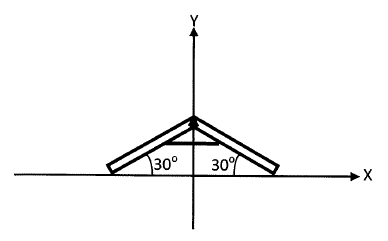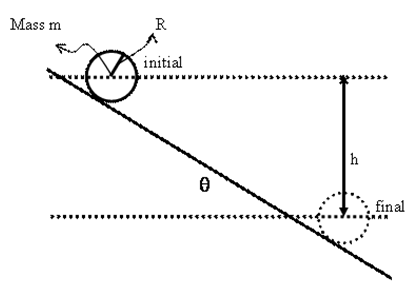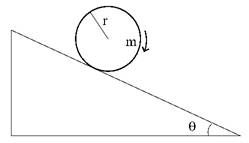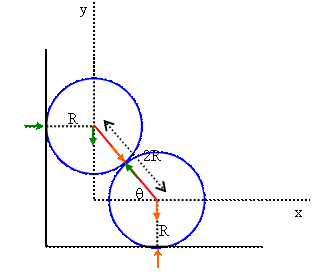Work and conservation of energy
Work
Problem:
A cyclist intends to cycle up a 8o
hill whose vertical height is 150 m with constant speed. If each complete revolution of the pedals
moves the bike 6 m along its path, calculate the average force that must be
exerted on the pedals tangent to their circular path. Neglect work done by
friction and other losses. The pedals turn in a circle of diameter 30 cm. The
total mass of the cyclist and his bike is 100 kg.
Solution:
- Concepts:
Work and energy
- Reasoning:
The work done by the cyclist changes the potential energy of the system.
- Details of the calculation:
The net work done by the cyclist is during
one revolution of the pedals is
W = mg∆h = 100*9.8*6*sin(8o) J =
818 J.
During one one revolution the pedal travels
a distance s.
W = <F>*s = <F>*2π(0.15 m) = (0.942 m)*<F>
<F> = (818 J)/( (0.942 m) = 868 N
Conservation of energy
Problem:
A pencil of length L is held vertically with its point on a desk and then
allowed to fall over. Assuming that the point does not slip, find the
speed of the eraser just as it strikes the desk. Compare this with the
speed that would result from free fall from a height equal to the length of the
pencil.
Solution:
- Concepts:
Energy conservation
- Reasoning:
Gravity is a conservative force. We have pure rotation
about a point.
- Details of the calculation:
½Iω2 = mgL/2. I = mL2/3.
ω2 = 3g/L. vtip = ωL = (3gL)½.
Speed
of eraser that falls freely from a height L: v = (2gL)½.
[½mv2 = mgL]
Problem:
Two thin beams of mass m and length l are connected by a frictionless hinge
and thread.

The system rests on a smooth surface. At t = 0 the thread is cut. Neglect
the mass of the hinge and the treat.
(a) Find the speed of the hinge when it hits the floor.
(b) Find the time it takes for the hinge to hit the floor in terms of an
integral.
Solution:
- Concepts:
Energy conservation
- Reasoning:
The system is frictionless. The symmetry of the problem tells us that the
hinge will fall vertically. The potential energy of the two beams will be
converted into translational kinetic energy of their CMs and rotational
kinetic energy about their CMs.
- Details of the calculation:
(a) For a given angle θ, the CMs of beams 1 and 2 are at positions
x1 = ½lcosθ, y1 = ½lsinθ, x2 =
-½lcosθ, y2 = ½lsinθ.
Their velocity components are
dx1/dt = -½lsinθdθ/dt, dy1/dt = ½lcosθdθ/dt,
dx2/dt = ½lsinθdθ/dt, dy2/dt = ½lcosθdθ/dt.
The speed of the CM of each rod is v = [¼l2(dθ/dt)2]½
= ½l|dθ/dt|
and its angular speed about its CM is is |dθ/dt| = ω = 2v/l.
The speed of the hinge is vh = 2v.
The moment of inertia if each rod about its CM is I = ml2/12.
The kinetic energy of the system is 2[½mv2 + ½Iω2]
= ¼ml2(dθ/dt)2 + (1/12)ml2(dθ/dt)2
= (1/3)ml2(dθ/dt)2.
The potential energy of the system is mglsinθ.
Energy conservation: (1/3)ml2(dθ/dt)2 + mglsinθ =
mglsin(30o) = ½mgl.
(dθ/dt)2 = (3g/l)(0.5 - sinθ).
When θ = 0 the |dθ/dt| = (3g/(2l))½, vh = l|dθ/dt| = (3lg/2))½.
This is the speed with which the hinge hits the floor.
(b) dt = dθ/[dθ/dt], t = -∫30 deg0
dθ/[(3g/2l)(1 - 2sinθ)]½ = (2l/3g)½∫030
deg
dθ/(1 - 2sinθ)½.
Problem:
Galileo wants to demonstrate that unequal masses fall with a uniform
acceleration by dropping two spherically symmetric masses simultaneously from
the same height z. Ideally we know that they should hit the ground at the same
time, t = (2z/g)½, where g is the acceleration due to gravity.
Unfortunately for Galileo, the surface of the first sphere is slightly
irregular, so the otherwise negligible air drag induces a rotation with an
angular frequency proportional to the velocity, ω = εv1. The second
sphere does not rotate. Assume that ε is constant and ignore possible heating
of the air by friction.
Find the ratio of impact times t1/t2 of the two spheres.
The answer should involve only the coefficient ε and the mass m1 and
moment of inertia I1 of the first sphere.
Solution:
- Concepts:
Energy conservation
- Reasoning:
Gravitational potential energy is converted into kinetic energy. The
rotating sphere has translational as well as rotational kinetic energy.
- Details of the calculation:
For the non-rotating sphere we have as a function of the distance z' below
the point of release
mgz' = ½mv2, v2(z') = 2gz'. This yields t(z') =
(2z'/g)½.
For the rotating sphere we have as a function of the distance z' below the
point of release
m1gz' = ½m1v12 + ½I1ω2
= ½m1v12 + ½I1ε2v12
= ½(m1 + ε2I1)v12,
v12 = 2g[m1/(m1 + ε2I1)]z'.
This yields t1(z') = (2z'/g')½, with g' = g[m1/(m1
+ ε2I1)].
Therefore t1/t2 = (g/g')½ = [(m1
+ ε2I1)/m1)]½.
Problem:
Find the fraction of the kinetic energy that is
translational and rotational when
(a) a hoop
(b) a disc and
(c) a sphere rolls down an inclined plane of height h. Find the velocity at
the bottom in each case. Compare with a block sliding without friction down the
plane.
Solution:
- Concepts:
The moment of inertia, energy conservation, rolling
- Reasoning:
Energy conservation: Tf = mgh = ½mv2 + ½Iω2
For rolling ω = v/r, so Tf = ½v2[m + I/r2] =
mgh.
- Details of the calculation:
The moments of inertia of the
hoop, disk, and sphere with radius r are
Ih = mr2, Id = mr2/2
and Isp = 2mr2/5, respectively.
Tkin/Tf = m/[m + I/r2], Trot/Tf
= (I/r2)/[m + I/r2] = I/[mr2 + I]
v = [2mgh/(m + I/r2)]½
For a block Trot = 0, Tkin/Tf
= 1, v = (2gh)½
(a) hoop: Tkin/Tf = Trot/Tf
= ½, v = (gh)½ = ½½vblock.
(b) disk: Tkin/Tf =
(2/3), Trot/Tf
= (1/3), v = (4gh/3)½ = (2/3)½vblock.
(c) sphere: Tkin/Tf = 5/7, Trot/Tf
= 2/7, v = (10gh/7)½ = (5/7)½vblock.
Problem:
A sphere of radius R and uniformly distributed mass m is released at rest and
begins moving down an inclined plane which makes an angle q with the horizontal.
The sphere reaches a final position as indicated, with its center at ∆z = -h
relative to its initial position. The gravitational force on the sphere is
F = -mg k.

(a) If the surface is frictionless, so the sphere slips without
rotating,
(i) what is the time t required to go
from the initial to the final position and
(ii ) what is
the final velocity of the sphere?
(b) Now assume that the surface has sufficient friction so that the
sphere rolls without slipping. In that case, what is the final velocity of
the central point of the sphere?
Solution:
- Concepts:
Newton's 2nd law, energy conservation
- Reasoning:
We have a sphere sliding or rolling down an inclined
plane.
- Details of the calculation:
(a) F = ma = m d2s/dt2
= mgsinθ. d2s/dt2 = gsinθ. v = ds/dt = gsinθt, s =
½gsinθt2.
The sphere travels a distance s = h/sinθ. h/sinθ
= ½gsinθt2. t2 = 2h/(gsin2θ).
The time
t required to go from the initial to the final position is t = (2h/g)½(1/sinθ).
mgh = ½mv2, v = (2gh)½
is the final velocity of the sphere.
(b) ½mv2 + ½Iw2
= mgh, I = 2mR2/5 for a uniform sphere, w = v/R for rolling.
½mv2 + mv2/5 = mgh, 7v2/10 = gh, v =
(10gh/7)½
is the final velocity of the central point of the sphere.
Problem:
A cylindrical shell rolls without slipping down an incline as shown below.
If it starts from rest, how far must it roll along the incline to obtain a
speed v?

Solution:
- Concepts:
Energy conservation, rolling
- Reasoning:
Gravity is a conservative force.
Rolling: ω = v/r.
Energy conservation: ½mv2 + ½Iω2 = mgΔh.
- Details of the calculation:
I = mr2, therefore v2
= gΔh.
Δh = Δs*sinθ, therefore Δs = v2/(g sinθ) is the
distance the cylindrical shell must roll.
Problem:
A cylinder of mass m, radius r, and length l rolls straight down an inclined
plane of length L and angle 30o with respect to the horizontal. A sphere
of mass M, and radius R rolls down another inclined plane, also of length L but
at an angle θ with respect to the horizontal. Each object is solid, of
uniform density, and rolls without slipping. Find an expression for the
angle θ for which the two objects reach the bottom at the same time after they
are released from rest at the same time.
Solution:
- Concepts:
Rigid-body motion, energy conservation, rolling
- Reasoning:
The accelerations should be equal for the objects are to
reach the bottom at the same time; the lengths L of the inclines does not
matter.
- Details of the calculation:
The moments of inertia are Icyl
= ½mr2, Isph = (2/5)Mr2. The length of
the cylinder does not matter.
| potential energy lost| = |kinetic
energy gained|
For the cylinder: mgL sin(30o) = ½mv2
+ ¼mr2(v2/r2) = ¾mv2 = ¾m 2aL,
a = (2/3) g sin(30o),
since v2 - v02
= 2aL for motion with constant acceleration.
For the sphere: MgL sin(θ)
= ½Mv2 + (1/5)Mr2(v2/r2) =
(7/10)Mv2 = (7/5)MaL,
a = (5/7) g sin(θ).
The
acceleration does not depend on the radii and masses of the cylinder and the
sphere,
Equating (2/3) g sin(30o) = (5/7) g sin(θ), sin(θ)=
(14/15)sin(30o),
θ = sin-1(7/15) = 27.8o.
Problem:
An inclined plane of length L makes an angle θ > 0o with respect
to the horizontal. A very thin ring with radius R rolls down this plane.
It reaches the bottom in time Δtring.
(a) If a uniform density
disk or sphere with the same radius R roll down this plane, at what time do they
reach the bottom? Find Δtdisk/Δtring and Δtsphere/Δtring.
(b) If all three object should reach the bottom at the same time Δtring,
one needs to vary the angle θ for the disk and the sphere. Find sinθdisk/sinθ
and sinθsphere/sinθ.
Solution:
- Concepts:
Rigid-body motion, energy conservation, kinematics
- Reasoning:
Energy conservation: mgLsinθ = ½mv2 + ½I(v2/r2)
Kinematics: v2 = 2aL, a = ½gsinθ, L = ½at2, t =
(2L/a)½
- Details of the calculation:
(a) Ring:
Energy conservation:
mgLsinθ = ½mv2 + ½mr2(v2/r2),
gLsinθ = v2.
Kinematics: v2 = 2aL, a = ½gsinθ, L
= ½at2, t = (2L/a)½ = (4L/(gsinθ))½.
Disk:
Energy conservation: mgLsinθ = ½mv2 + ½(½mr2)(v2/r2),
gLsinθ = ¾v2.
Kinematics: v2 = 2aL, a =
(2/3)gsinθ, L = ½at2, t = (2L/a)½ = (3L/(gsinθ))½.
Sphere:
Energy conservation: mgLsinθ = ½mv2 + ½(2/5)mr2(v2/r2),
gLsinθ = (7/10)v2.
Kinematics: v2 = 2aL, a =
(5/7)gsinθ, L = ½at2, t = (2L/a)½ = (14/(5gsinθ))½.
Δtdisk/Δtring = (3/4)½.
Δtsphere/Δtring
= (7/10)½.
(b) The same acceleration will produce the same
time Δt.
Disk: (2/3)gsinθdisk = ½gsinθ, sinθdisk/sinθ
= ¾.
Sphere: (5/7)gsinθdisk = ½gsinθ, sinθdisk/sinθ
= 7/10.
Problem:
Two identical uniform cylinders of radius R each are placed on top
of each other next to a wall as shown. After a
disturbance, the bottom cylinder slightly moves to the right and the
system comes into motion. Find the maximum subsequent speed of
the bottom cylinder. Neglect friction between all surfaces.

Solution:
- Concepts:
Energy conservation
- Reasoning:
No friction --> no torque
The cylinders will not
rotate.
Assume a constraint. The cylinders will stay in contact.
Calculate the velocity of the bottom cylinder as a function of X, the
horizontal position of its center, using energy conservation.
Calculate
its acceleration a function of X. At the horizontal position X for which dvx/dt
= 0, the acceleration changes sign. The force of constraint now must pull
on the lower cylinder to keep the cylinders in contact. This constraint cannot be met. The cylinders
will not stay in contact. The lower cylinder will slide to the right with
the horizontal velocity it has at the horizontal position X for which dvx/dt
= 0. Because its acceleration and its velocity have both pointed in the
positive x-direction before the cylinder reached that position X, the speed
the lower cylinder has at that position is its maximum speed.
- Details of the calculation:

Let M be the mass of each cylinder and R the radius. Assume the
cylinders stay in contact.
Energy conservation:
Mg(2R - 2Rsinθ) = ½
M(vx2 + vy2)
The upper
cylinder is moving down and the lower cylinder is moving towards the right.
vx2 + vy2 = 4Rg(1 - sinθ)
X =
2Rcosθ, Y = 2Rsinθ,
vx = dX/dt, vy = dY/dt, vx2
+ vy2 = 4R2(dθ/dt)2
(dθ/dt)2
= (g/R)(1 - sinθ)
Energy conservation yields dθ/dt in terms of the angle
θ. Since vx is proportional to dθ/dt, we can now find vx
and dvx/dt in terms of θ, and therefore find the angle θ for
which dvx/dt = 0.
vx = -2R sinθ dθ/dt, vx2
= 4Rg(sin2θ - sin3θ)
dvx2/dt
= (dvx2/dθ)(dθ/dt) = 2vx(dvx/dt)
dvx2/dt = 4Rg(2sinθ - 3sin2θ) (dθ/dt)
dvx/dt
= dvx2/dt = 0 if 2sinθ - 3sin2θ = 0.
sinθ = (2/3), dθ/dt = -(g/3R)½, vx = (4/3)(gR/3)½.
The maximum speed of the bottom cylinder is (4/3)(gR/3)½.





